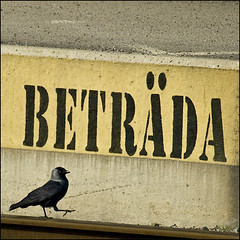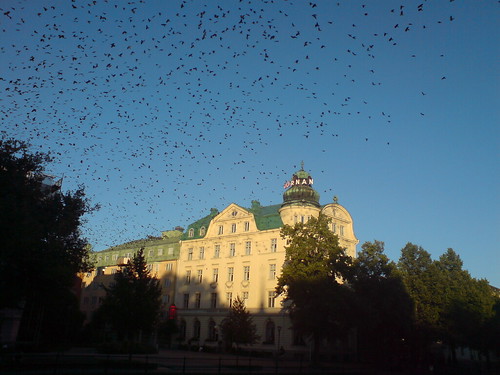 |
| Picture Source:sweron |
Jennifer, however, reads the local paper in another format (this sort of, well, papery format, in which it is apparently available every day), so instead of joining in my mockery of the state of automatic language translation technology, she simply pointed out the restaurant review section in said paper. I'll be darned if the bottom of each review didn't have a row of between one and five little crow icons. Except, of course, that they weren't crows at all, but rather jackdaws.
 |
| Jackdaws massing in central Uppsala. Picture Source: woo-hoo and Animal Photos |
We noticed the jackdaws as soon as we got to Uppsala. There's no way not to, really: according to recent estimates, there are upwards of 100,000 of them around the city. They're like small crows, but with dark grey heads (a little more rounded at the top than a crow's) and a metallic "chyak chyak" call that's quite distinctive. They are by far the most commonly seen bird in and around the city, and nearly the only corvids (apart from a few magpies and the occasional raven). On a quiet evening it isn't unusual to hear and/or see a flock of a couple hundred jackdaws wheeling about some building top or another in downtown Uppsala, and the fields of the farms around the city are generally full of them most of the day.
Now that we've become aware of the jackdaw as symbol, though, it turns out that those are all around us as well. This afternoon, for example, I was in the city library (I've got finals coming up, I need to procrastinate somewhere). What do I see when I pull out my library card? Yup, jackdaw. Meanwhile, next to the checkout counter, there's a small table where a couple of young women are selling passes to the upcoming Uppsala International Short Film Festival. The name of the first prize in each category at the festival? It's an Uppsala Jackdaw, of course. There's even a local 50 and over hockey team called the Jackdaws. It seems to be a sort of unofficial Uppsala mascot.
Turns out that the bird's symbolic popularity in these parts isn't just due to its numbers. The Nordic jackdaw subspecies is found through most of the southern part of Sweden and Norway, and all of Denmark, while further to the east is a Russian jackdaw subspecies. Both of these groups have a sort of lighter collar at the bottom of their grey hood. There's an intermediate population, with a lot of variation in collar coloring, including a small number with no collar at all, which is found in Finland and in Uppsala, but nowhere else in Sweden. The Uppsala population, though, is almost entirely made up of birds with no collar. All of which is to say, the birds in Uppsala are noticeably different than those in the rest of Sweden, so their local popularity makes sense.
This post rated:


No comments:
Post a Comment